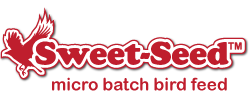Big or Small – Which Hummingbird Feeders Are Best?

Hummingbirds are tiny birds with hearty appetites, and hummingbird feeders come in all sizes to keep these flying jewels well-fed. Both big and small nectar feeders have pros and cons, however, and birders should consider the positives and negatives of each size as they decide which hummingbird feeder is best for their flock.
Hummingbird Feeder Sizes
Nectar feeders come in a wide variety of sizes, from tiny one-ounce feeders to humongous feeders with a capacity of 32-40 ounces or more. Small feeders are often grouped together in one apparatus, bracket, or cluster to form a feeding station with a larger capacity, while larger feeders are typically standalone models capable of hosting a hungry flock with ease.
In addition to capacity differences, the number of feeding ports also varies on different feeder sizes. The smallest hummingbird feeders usually only have a single port for the birds to sip, or may have at most 2-3 ports depending on the overall feeder style. Mid-size feeders typically have 4-6 feeding ports to allow several birds to feed at once, while the largest feeders may have 8-12 or more feeding ports, depending on their design and how close feeding ports may be spaced. In general, dish-style feeders or horizontal designs can often have more feeding ports, while upside down reservoir feeders have fewer feeding ports so the integrity of the feeder is not compromised and leaks are minimized.
Large Nectar Feeders
The largest hummingbird feeders can easily sate even the hungriest hummers with their tremendous capacities and multiple feeding ports. Other factors to consider with the biggest of the feeders include…
Pros:
- Larger feeders with exceptional capacities typically require fewer refills, even with more birds feeding and more nectar being consumed.
- Big feeders weigh significantly more and are much more stable in breezy areas to minimize leaks or tipping.
- Large feeders can accommodate larger hummingbird flocks, such as during migration or in late summer when more birds are visiting.
- Bigger feeders may be easier for birders with dexterity difficulties to handle because bigger parts can be easier to grip and twist.
Cons:
- If not emptied fast enough, large feeders may grow mold or fungus more easily and contaminate nectar.
- Larger, heavier feeders are typically too heavy to be attached to windows for intimate views, or they may bend smaller hooks.
- Big feeders may be easier for one aggressive hummingbird to defend, denying other birds time to feed.
- Larger feeders are easier for other, larger birds to sip from and may also attract other wildlife, such as raccoons and squirrels.
Small Nectar Feeders
The smallest hummingbird feeders are delicate and charming, but that doesn’t mean they’re better or worse than other feeder sizes. When considering small nectar feeders, take note of these factors…
Pros:
- Smaller feeders will be emptied much more quickly so there is less time for nectar to ferment or mold to get established.
- Small feeders are easier to place in many unique positions, such as in flower pots, on windows, or in any small, available space.
- Using many small feeders may help minimize hummingbird aggression because there are more feeders to visit and one bird can’t dominate the area as well.
- Smaller feeders are typically less expensive to purchase, particularly if a feeder breaks or a replacement is needed.
Cons:
- Small feeders only accommodate 1-2 birds at a time, with fewer feeding ports and less room for more birds to visit simultaneously.
- Smaller feeders are more lightweight and will more easily swing, sway, and tip in even light breezes, which could create leaks and waste nectar.
- Very small feeders are usually more delicate and may break more easily, especially if they catch the attention of other wildlife.
- Tiny feeders require more frequent refills, which can take up even more time with more feeders to refill.
Choosing Your Best Hummingbird Feeder Size
No matter whether you prefer larger feeders or tiny ones, it is best to choose the hummingbird feeder size that works for you and your birds. If you feed just a few hummingbirds, smaller feeders may be best, or you could offer one large feeder for the birds to share. If you have a larger hummingbird flock, larger feeders can accommodate the birds or you may opt for many small feeders to give the birds more feeding options. Many birders have nectar feeders in different sizes and swap them out as necessary when their flocks change or more natural, nectar-bearing flowers are available in different parts of the season. Whichever feeder size you choose, large or small, you’re sure to have great fun feeding hummingbirds and enjoying their company with each sweet sip.
